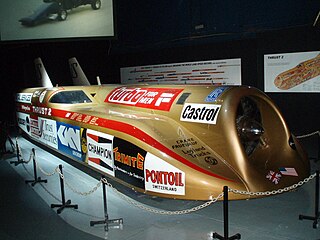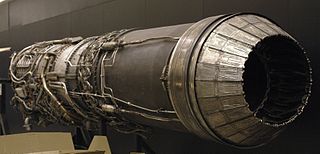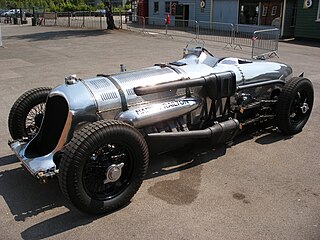
The land speed record (LSR) or absolute land speed record is the highest speed achieved by a person using a vehicle on land. By a 1964 agreement between the Fédération Internationale de l'Automobile (FIA) and Fédération Internationale de Motocyclisme (FIM), respective governing bodies for racing in automobiles and motorcycles, both bodies recognise as the absolute LSR whatever is the highest speed record achieved across any of their various categories. While the three-wheeled Spirit of America set an FIM-validated LSR in 1963, all subsequent LSRs are by vehicles in FIA Category C in either class JE or class RT.

Craig Breedlove was an American professional race car driver and a five-time world land speed record holder. He was the first person in history to reach 500 mph (800 km/h), and 600 mph (970 km/h), using several turbojet-powered vehicles, all named Spirit of America.

Thrust2 is a British-designed and -built jet-propelled car, which held the world land speed record from 4 October 1983 to 25 September 1997.

Spirit of America is the trademarked name used by Craig Breedlove for his land speed record-setting vehicles.

Royal Air Force Elvington or more simply RAF Elvington is a former Royal Air Force satellite station which operated from the beginning of the Second World War until 1992 located at Elvington, Yorkshire, England. It is now the location of the Yorkshire Air Museum.
Arthur Eugene Arfons was the world land speed record holder three times from 1964 to 1965 with his Green Monster series of jet-powered cars, after a series of Green Monster piston-engine and jet-engined dragsters. He subsequently went on to field a succession of Green Monster turbine-engined pulling tractors, before returning to land speed record racing. He was announced as a 2008 inductee in the International Motorsports Hall of Fame three days after his death.

The General Electric J79 is an axial-flow turbojet engine built for use in a variety of fighter and bomber aircraft and a supersonic cruise missile. The J79 was produced by General Electric Aircraft Engines in the United States, and under license by several other companies worldwide. Among its major uses was the Lockheed F-104 Starfighter, Convair B-58 Hustler, McDonnell Douglas F-4 Phantom II, North American A-5 Vigilante and IAI Kfir.
Walter Charles Arfons was the half brother of Art Arfons, his former partner in drag racing, and his competitor in jet-powered land speed record racing. Along with Art, he was a pioneer in the use of aircraft jet engines for these types of competition.

The Wingfoot Express was Walt Arfons and Tom Green's jet-powered land speed record car, driven by Green to a record on October 2, 1964, after Walt suffered a heart attack just prior. The Express was powered by a Westinghouse J46 engine and hit the 413 mph record mark.

Rosco McGlashan OAM was born on 23 August 1950 in Subiaco, Western Australia. Rosco is an Australian drag racing champion, who currently holds the Australian land speed record at 500 mph (802.6 km/h). This record was set on the 27 March 1994 on the dry salt flats of Lake Gairdner, South Australia, 440 km (270 mi) northwest of Adelaide.
The Vampire is a jet-propelled car that currently holds the outright British land speed record, driven by Colin Fallows to a speed of 300.3 mph (483.3 km/h) on 5 July 2000 at Elvington, Yorkshire, England.

The North American Eagle Project was a jet powered car that was intended to challenge the 763 mph (1,228 km/h) land speed record set by the ThrustSSC in 1997. The venture was a collaboration between Canadian and US engineers, pilots, and mechanics. In 2013, they had hoped to reach 800 mph (1,287 km/h), or Mach 1.058.

David Abbott "Ab" Jenkins was the 24th mayor of Salt Lake City, Utah between 1940 and 1944. He was a professional race car driver. Jenkins' interest in motorsports began with racing motorcycles on dirt tracks and across country. He then became interested in land speed records at the Bonneville Salt Flats. He was instrumental in establishing Bonneville as a location for such events, and in attracting overseas drivers such as George Eyston and Sir Malcolm Campbell to compete there.

A jet car is a car propelled by a jet engine. A jet dragster is a jet powered car used for drag racing. They are most commonly seen at race shows.
Bob "Crazy" Correll was an American daredevil and stuntman from Long Beach, California. According to his official biography from Balls, Unlimited, Inc., Correll enjoyed a varied career racing motorcycles, drag cars, stock cars, and go-carts. He also flew hang gliders, sail planes, powered planes, and hot-air balloons. From the 1970s to the late 1990s, Correll was associated with the following ventures:

The Westinghouse J46 is an afterburning turbojet engine developed by the Westinghouse Aviation Gas Turbine Division for the United States Navy in the 1950s. It was primarily employed in powering the Convair F2Y Sea Dart and Vought F7U Cutlass. The engine also powered the land speed-record car known as the Wingfoot Express, designed by Walt Arfons and Tom Green It was intended to power the F3D-3, an improved, swept-wing variant of the Douglas F3D Skyknight, although this airframe was never built.
Tom Green worked with Walt Arfons to design and drive the Wingfoot Express, a jet-powered land speed record car. Green drove the car to a world record speed 413.20 mph (664.98 km/h) on October 2, 1964. Green's world record is often forgotten, as the mark was eclipsed three times in less than two weeks, including the first to break the 500 mph (800 km/h) threshold.
The Red Baron was a highly modified Lockheed F-104 Starfighter which set a FAI Class C-1 Group III 3 km speed record of 1,590.45 kilometres per hour (988.26 mph), in 1977 which still stands. It was assembled by Darryl Greenamyer and sponsored by Ed Browning and the Red Baron Flying Service of Idaho Falls, Idaho. The aircraft was destroyed in an accident in 1978.

An aero-engined car is an automobile powered by an engine designed for aircraft use. Most such cars have been built for racing, and many have attempted to set world land speed records. While the practice of fitting cars with aircraft engines predates World War I by a few years, it was most popular in the interwar period between the world wars when military-surplus aircraft engines were readily available and used to power numerous high-performance racing cars. Initially powered by piston aircraft engines, a number of post-World War II aero-engined cars have been powered by aviation turbine and jet engines instead. Piston-engined, turbine-engined, and jet-engined cars have all set world land speed records. There have also been some non-racing automotive applications for aircraft engines, including production vehicles such as the Tucker 48 and prototypes such as the Chrysler Turbine Car, Fiat Turbina, and General Motors Firebirds. In the late 20th century and into the 21st century, there has also been a revival of interest in piston-powered aero-engined racing cars.
Land speed racing is a form of motorsport.
















